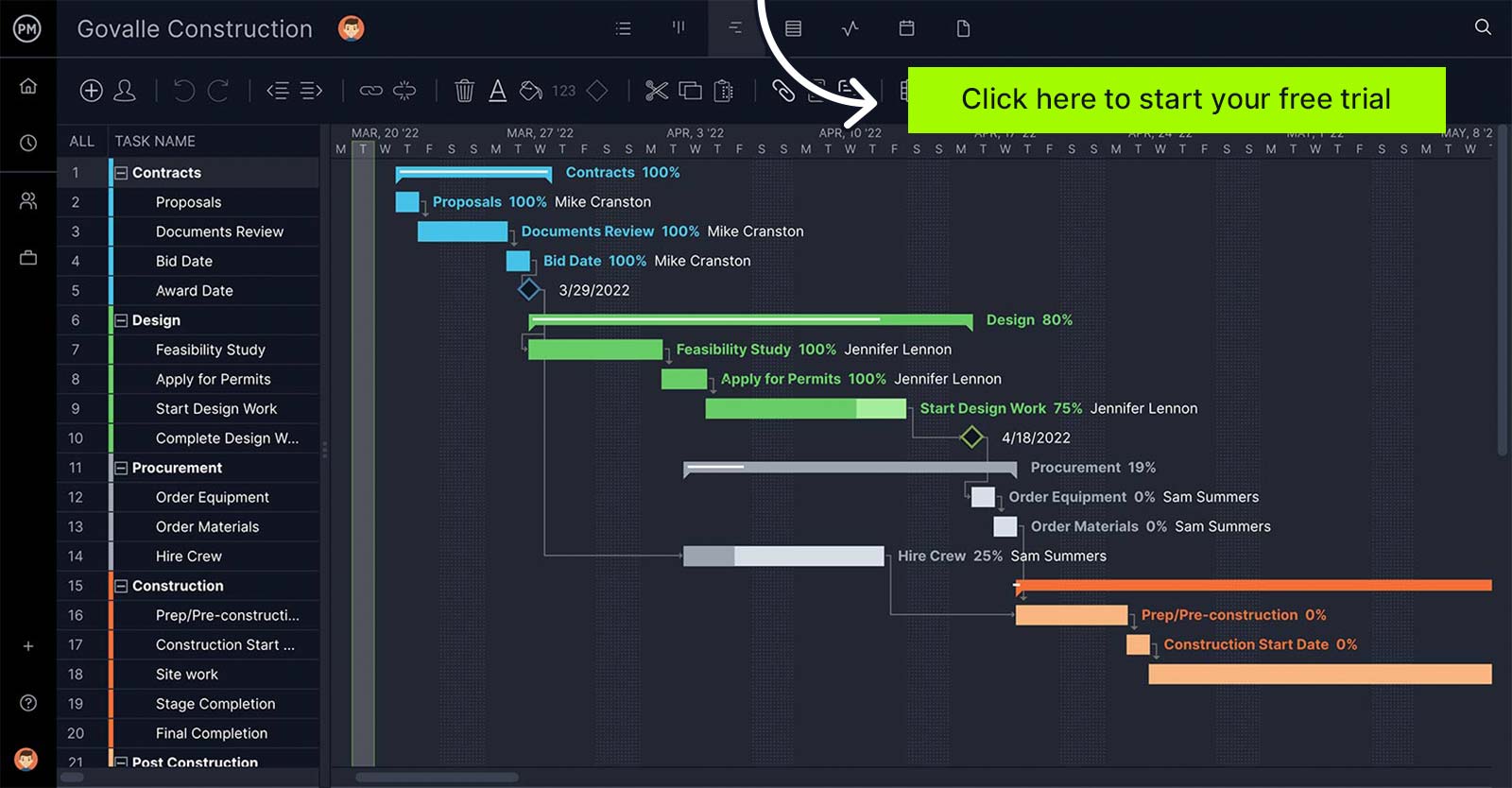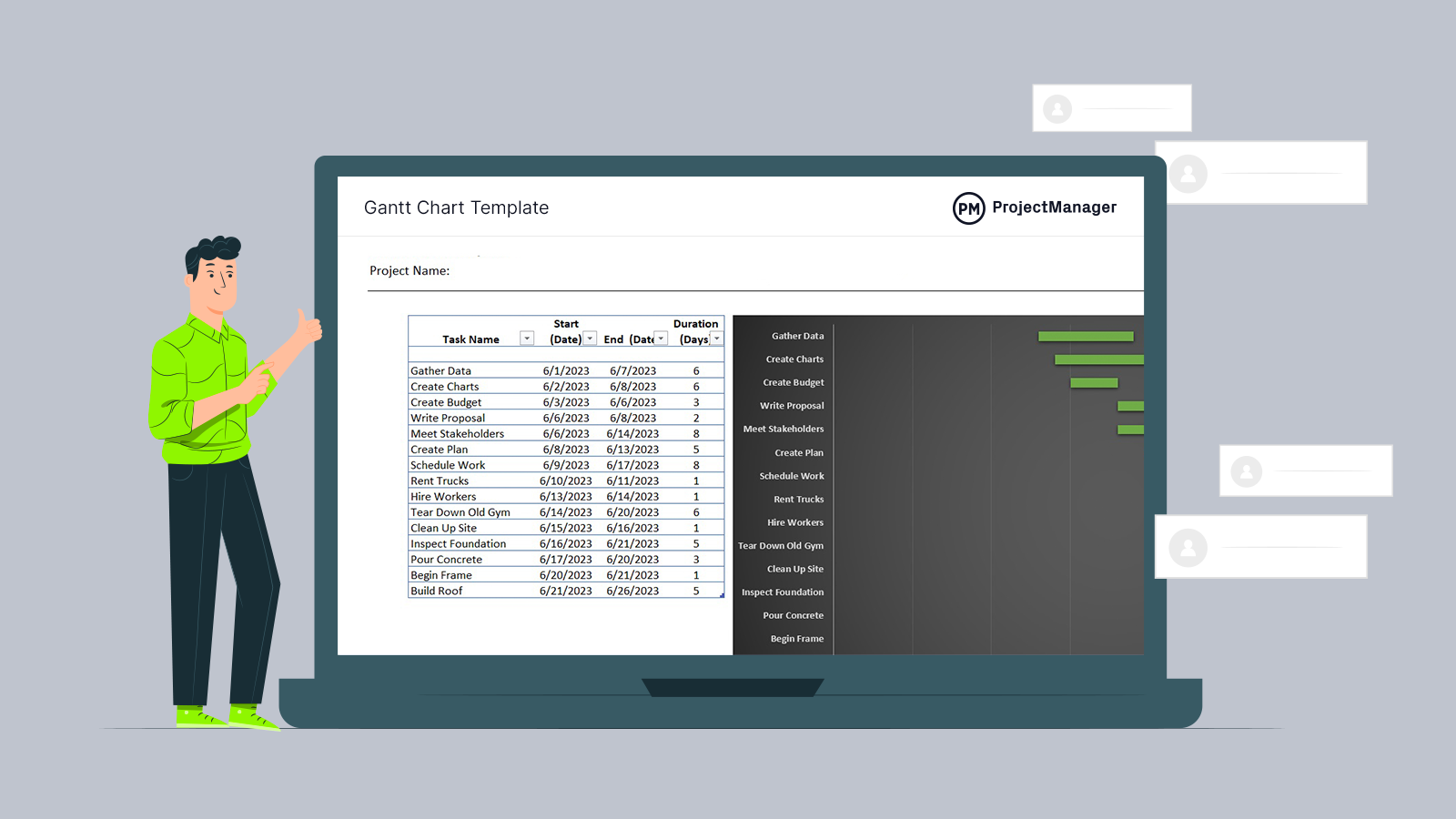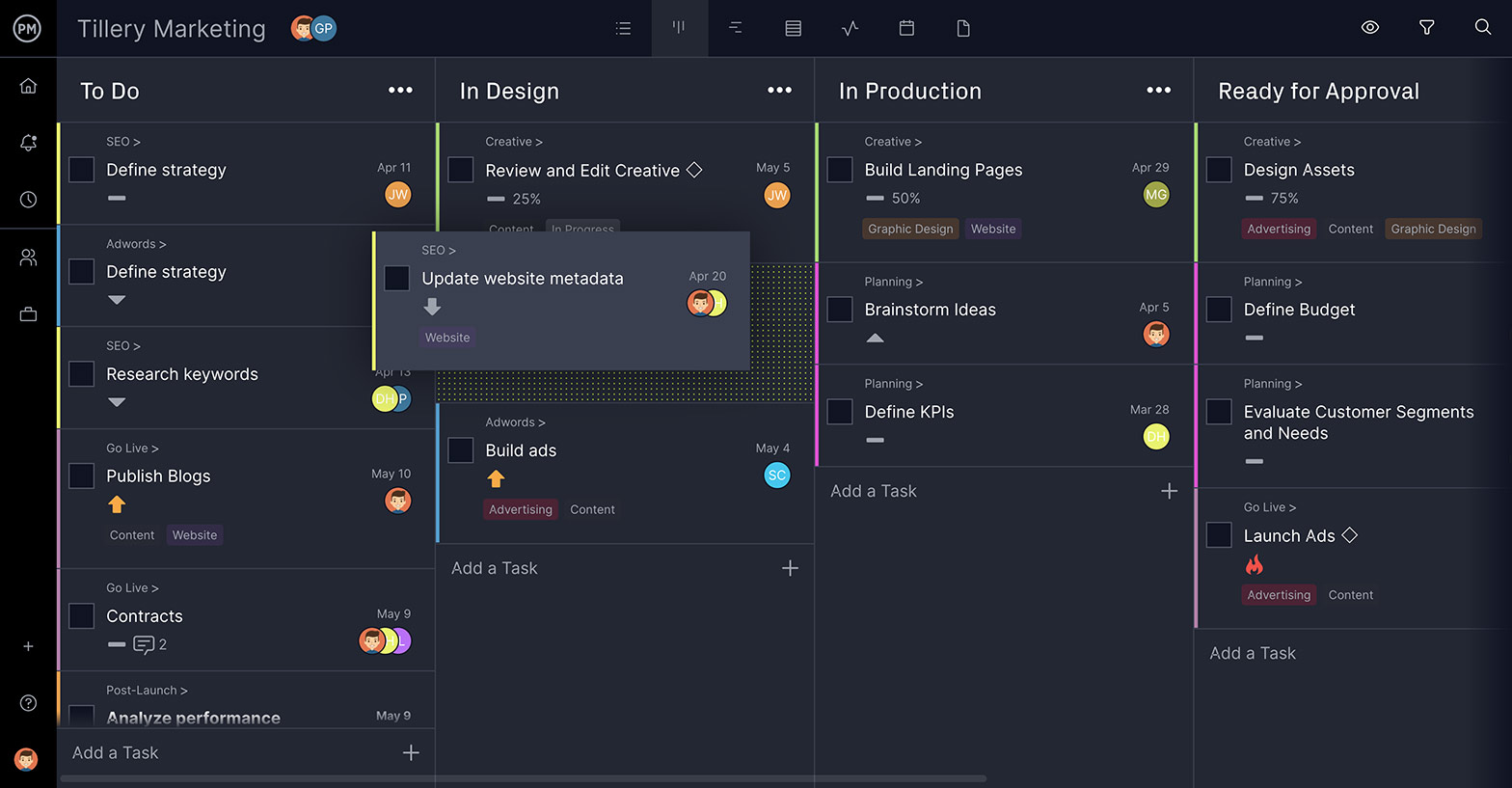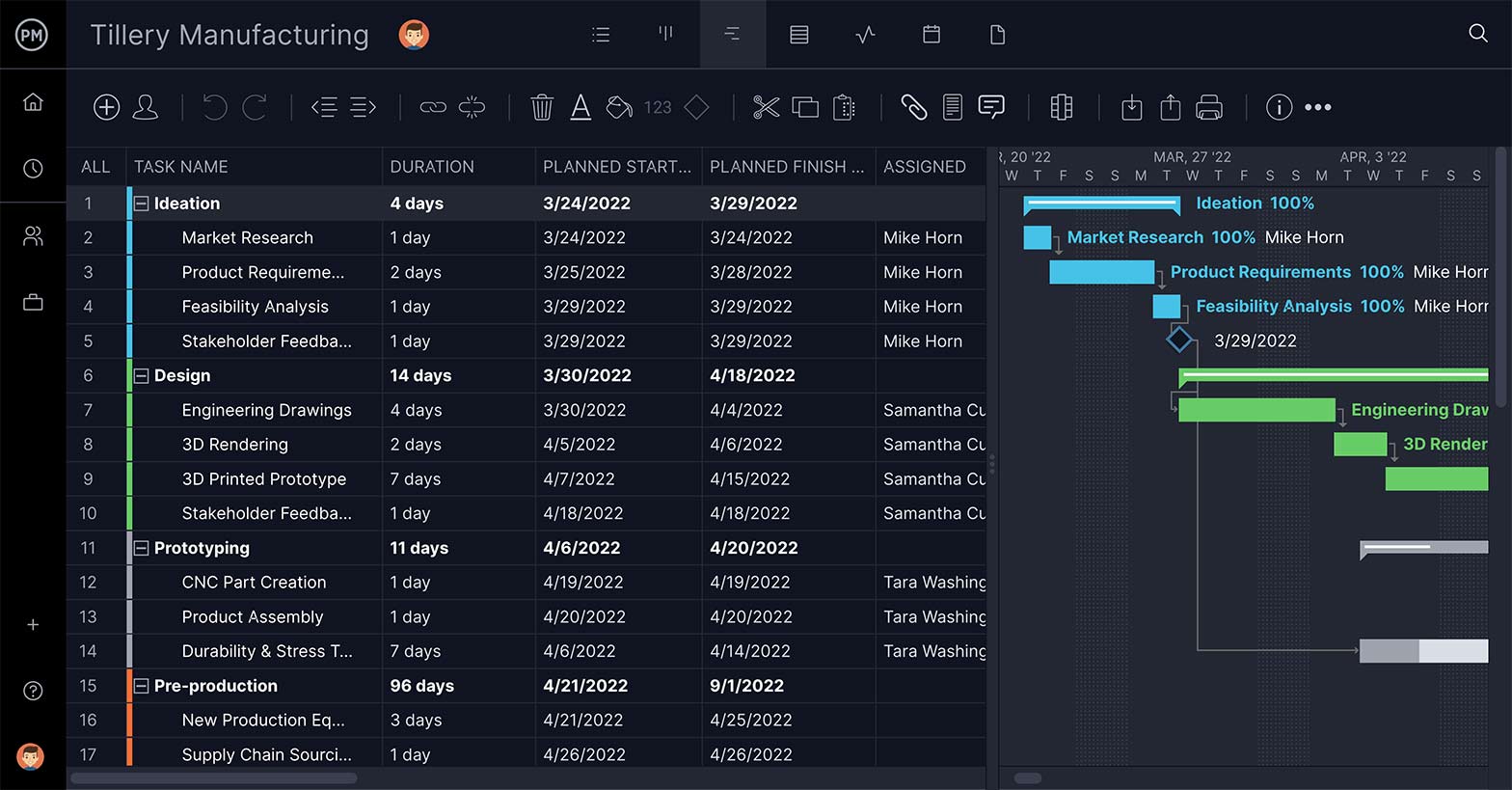A project never exists in a vacuum. Rather, a project is executed by a team within an organization that has some sort of a project management framework established to enable the process. This framework, whether deliberately designed or not, acts as a loose guide for how the project should function for teams across multiple channels.
This framework should be designed to suit the needs of your projects, goals and team. Read on to learn how to make a trustworthy project management framework that can help guide your projects to successful conclusions.
What Is a Project Management Framework?
A project management framework maps out the methods, processes, tasks, resources and tools needed to take the project from beginning to end. It’s typically broken into three parts: project lifecycle, project control cycle and tools & templates.
One of the tools that help map the project life cycle and, in turn, helps control project execution is a Gantt chart. ProjectManager, an online work and project management software, offers Gantt charts that do more than organize tasks, link dependencies and set milestones. You can also filter for the critical path without having to configure complex calculations. Once you have a schedule, set the baseline and begin tracking the planned effort against your actual effort to stay on schedule. Get started with ProjectManager for free.

Project Framework vs. Project Methodology
This can be a common source of confusion, but it’s simple to untangle. A project methodology acts as a set of processes or principles that best help manage a project. Methodologies are usually strictly defined and reinforced—they’re formal for a reason. Without a strict code in place for your methodology, the project can fall apart.
Meanwhile, you have more freedom and flexibility within a framework. The main difference is that a project management framework can mix elements from several project management methodologies to establish a project management system for an organization.
Therefore, a project management framework allows project managers to change rules, adopt new rules mid-framework and abandon rules as needed. Plus, a framework includes much more detail—it even has phases that might not be included in a methodology such as complex onboarding processes and post-go-live assessments.

Get your free
Gantt Chart Template
Use this free Gantt Chart Template to manage your projects better.
Get the Template
10 Project Management Framework Examples
There are many common types of frameworks designed for different projects, team sizes, industries and budgets. Here are some project management framework examples.
1. Waterfall Project Management Framework
This project management framework is a linear, sequential process that involves completing each phase of a project before moving on to the next. The phases are similar to a cascading waterfall, which is where it gets its name, with each phase building on the previous one’s deliverables and feedback.
2. Agile Project Management Framework
Agile is a project management framework that breaks large projects into smaller, more focused parts so teams can work in short, incremental phases called sprints. The name refers to moving quickly and managing shifting priorities.
3. Kanban Project Management Framework
Kanban is a visual project management framework that uses boards to help teams improve workflows, reduce waste and increase team focus. The term comes from the Japanese word for sign or visual board and the framework was first developed by Toyota engineer Taiichi Ohno in the 1940s.
4. Critical Path Method Project Management Framework (CPM)
This project management framework helps determine a project’s duration and identify tasks necessary for completion. It’s a step-by-step process that involves breaking a project down into individual tasks, evaluating the resources and duration of each and considering the relationships between them. The critical path method identifies the longest sequence of activities that must be completed on time for the project to be finished, which is known as the critical path.
5. Critical Chain Project Management Framework (CCPM)
This is a project management framework that focuses on resources to help teams complete projects as efficiently as possible. Critical chain project management involves identifying the steps, timelines and resources needed to complete a project and then creating a roadmap to ensure the project is completed on time and within budget.
6. Program Evaluation and Review Technique (PERT)
This project management framework helps plan and organize complex projects by estimating how long it will take to complete them. PERT charts are used to plan tasks, which can help with scheduling deliverables and coordinating with team members.
7. Project Management Body of Knowledge (PMBOK)
The project management body of knowledge (PMBOK) is a collection of processes, best practices, terminologies and guidelines that are accepted as standard within the project management industry. It’s published by the Project Management Institute (PMI).
8. PRINCE2 Project Management Framework
PRINCE2, which stands for projects in controlled environments, is a project management framework used worldwide but is mostly found in Europe. It’s a linear framework that focuses on moving projects through predefined stages and emphasizes organization and control. It can be scaled and tailored to each project and can help develop the skills needed to become a successful project manager.
9. Six Sigma Project Management Framework
Six Sigma is a project management framework that uses data and statistical analysis to improve processes, reduce waste and increase customer satisfaction. It’s a disciplined approach that can help organizations improve their products, services and processes in production, marketing, finance, administration and other industries.
10. Hybrid Project Management Framework
This project management framework is a flexible and adaptable approach that combines the best elements of traditional and agile project management methodologies. It allows businesses to balance structure and flexibility and to tailor project management techniques to meet the specific needs of a project. For example, Scrumban is a combination of scrum and kanban.

Key Elements of a Project Management Framework
We’ve already briefly touched on these three elements: the project lifecycle, project control cycle and tools and templates. These three elements are not carried out in any one specific order, but when combined, they help the project function at optimal levels. Let’s take a deeper dive into these three elements.
Tools & Templates
As previously mentioned, there’s no need to reinvent the wheel, considering all of the templates already available online. Popular templates include PRINCE2, CCPM (critical chain project management), scrum (primarily used in development environments) and the waterfall methodology. Many Gantt charts employ the waterfall methodology in their makeup, so it’s an easy transition to make should you migrate from software to software.
The actions in a framework can either be sequential—ideal for a waterfall methodology—or simultaneous, which a kanban board can support.
Project Life Cycle
The project life cycle outlines how you’ll set up your overall project management framework. You’ll start mapping out your project management framework by referencing your project lifecycle. There are typically five phases that make up the project lifecycle: initiation, planning, execution, management and review.
- Initiation: Initiation consists of research, planning, coordinating with both stakeholders, brainstorming ideas and interviewing customers/stakeholders/partners/manufacturers for input.
- Planning: Now that you’ve identified the key components to successfully create the project, you can start putting the pieces of the puzzle together. Where does each milestone go? How many teams will be involved? What are the risks for each team, and who will manage them? All these questions and more will be answered and signed off on by the stakeholder team during this phase.
- Execution: The project kicks off! Now that all relevant team members have the creative brief, the project will move into the production phase for designers, developers, writers and other members to produce deliverables.
- Monitoring: This project management phase is where you’ll monitor, review and report all updates—particularly at each milestone—to key stakeholders. Additionally, you’ll want to make a note of everything just in case, anomaly or not, and keep all notes in a repository to refer back to at a later date.
- Closing: The project is complete and the deliverable has been successfully delivered. At the closing stage, you’ll review all notes, key successes and points that could improve with stakeholders, team members, customers and manufacturers.
This is why, arguably, the lifecycle stage is the biggest and most important component of your project management framework. The lifecycle often acts as a tool to show key stakeholders each stage against each milestone and what goals will be accomplished at each point. Each new phase and milestone reached is another measurable metric to report once the project is complete.
Project Control Cycle
This is the monitoring and management portion of your project. At this phase, you’ll use software to combine communication across channels into one area. Different project management metrics help record the progress of all team members, monitor for possible risks that you’ve already identified and manage the expectations of key stakeholders.
Depending on how large your team is and how many countries and time zones in which it operates, this can be as long of a process as the project lifecycle portion of the project. That’s because when you’re dealing with people, you’re dealing with variables. In every variable, there’s a risk.
Unfortunately, as many as 57% of leadership teams surveyed said the risk was one facet they felt least prepared to deal with, and only 36% of companies have a plan in place to address risk appropriately. The project would likely fail without a project manager appropriately managing and monitoring the risks, optimizing the program throughout the process and creating channels for open communication.
Project Management Framework Best Practices
- Keep a controlled method of communication. Without a method where communication is open across multiple channels and teams, the framework could easily collapse.
- Create templates to use across similar project types. Because a framework is so flexible, you can use a framework for multiple project types without reinventing the wheel, so to speak. This can help improve efficiency across all teams involved.
- Create a repository for all notes, documents and comments on the project and milestones reached. This can be useful for the review phase as well as when you create a new project framework. You can use the lessons learned from the previous project to modify the new framework for more efficiency.
Since a framework is so flexible and intuitive, it’s fairly difficult for it to fail. But by using these best practices, you can ensure that it succeeds every time.
Free Project Management Templates
We offer dozens of free project management templates to help you implement any project management framework. We also offer industry-specific templates for manufacturing, product development, construction and more.
Gantt Chart Template
Gantt charts are versatile project management tools that can be used when working with any project management framework including waterfall, lean and even agile. Download our free Gantt chart template for Excel and then migrate it to ProjectManager to use our fully-featured online Gantt chart.
Work Breakdown Structure Template
One of the most important steps in the project planning process is to define your project scope. Our free work breakdown structure for Excel is the perfect tool to do that. Then you can use our online Gantt chart, which has a built-in work breakdown structure feature.
Project Budget Template
Creating a project budget can be overwhelming for many. That’s why we created our free project budget template for Excel, which can be helpful for any project you’re working on, regardless of the project management framework that you’re using.
ProjectManager Can Help With Your Framework
Creating and implementing a project management framework across multiple teams is never easy. But with a software solution with a framework template built in, you won’t have to start from scratch.
Kanban Boards for Work Management
With ProjectManager, you can cut back on emails by implementing our kanban board tool. Visualize your workflow for maximum efficiency, easily update task progress, set priorities and give team members the autonomy to comment and report updates to you.

Gantt Charts Are Ideal for Any Project Management Framework
With our cloud-based Gantt charts, you can plan projects, assign tasks, manage deadlines and link assignments with their dependencies. No matter where your team is, as soon as a task is updated, all associates will be updated accordingly.

Real-Time Dashboard for Better Project Management
Managing and reporting are easier than ever with our real-time dashboard. Our reports are fully customizable to get you the data you need. Plus, with the data all in one view, you can see the status of each task instantly.

Project management frameworks don’t have to be rigid, they just have to be successful. With ProjectManager, guide your team members toward new milestones, updated tasks, and new deadlines with the software they need to collaborate effectively no matter where they’re located. Sign up for our free 30-day trial today.

